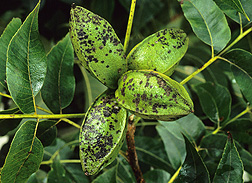Compound from Bacteria Could Be Useful Against Pecan Scab
|
|
Plant pathogens can cause disease and yield loss in many crops, including nut trees such as pecan, known scientifically as Carya illinoinensis. Pecan scab, caused by the plant-pathogenic fungus Fusicladium effusum, is the major disease currently limiting productivity and quality of pecan trees in the southeastern United States.
Researchers know that substances produced by bacteria from the guts of entomopathogenic nematodes (ones that infect insects) can suppress certain plant diseases, including pecan scab. But the specific compounds responsible for the suppression have not been previously identified.
At the Agricultural Research Service’s Fruit and Tree Nut Research Laboratory in Byron, Georgia, plant pathologist Clive Bock and entomologist David Shapiro-Ilan, along with ARS chemist Charles Cantrell and plant pathologist David Wedge, examined chemical extracts of the bacteria to identify the major components responsible for suppressing pecan scab. They found that the extracts most effective against pecan scab came from the bacterium Photorhabdus luminescens (VS strain). Cantrell and Wedge are in ARS’s Natural Products Utilization Research Unit in Oxford, Mississippi.
“We recently explored the use of naturally occurring antimicrobial compounds produced by Xenorhabdus and Photorhabdus bacteria. These bacteria live in the guts of entomopathogenic nematodes in the genera Steinernema and Heterorhabditis, respectively; the bacteria are critical in helping the beneficial nematodes kill their insect hosts,” says Shapiro-Ilan. “The bacteria can be cultured in media. Extracts of the cultures contain the antimicrobial metabolites, which are active against a wide range of microbial pathogens of animals and plants, including bacteria and fungi.”
The extract found to be most toxic to the pecan scab fungus was purified and found to contain trans-cinnamic acid. Laboratory test results showed that trans-cinnamic acid was toxic to the pecan scab fungus in tiny amounts, as low as 148-200 micrograms per milliliter in solid culture and 64 micrograms per milliliter in liquid culture.
“While some host [pecan] resistance is available to reduce the impact of pecan scab, new strains of the pathogen have been able to overcome that resistance,” says Bock. “Conventional chemical fungicides have been widely used to control scab, but sometimes more than 10 sprays are required to ensure adequate control of the disease. As a result, F. effusum is now resistant to at least two classes of fungicides.”
There is also an increasing awareness of the environmental impact of conventional pesticides. “There are important incentives to try to develop alternatives to conventional fungicides—alternatives that are of low environmental risk and that present a lower risk of fungicide resistance developing in the pathogen,” says Bock. These naturally occurring antimicrobial products might offer such an alternative.
This work was published in the Journal of Pest Science in March 2014.—By Sharon Durham, Agricultural Research Service Information Staff.
This work is part of Plant Diseases (#303) and Crop Production (#305), two ARS national programs described at www.nps.ars.usda.gov.
Clive Bock and David Shapiro-Ilan are with the USDA-ARS Fruit and Tree Nut Research Laboratory, 21 Dunbar Rd., Byron, GA 31008; (478) 956-6409 [Bock], (478) 956-6444 [Shapiro-Ilan].
"Compound from Bacteria Could Be Useful Against Pecan Scab" was published in the September 2014 issue of Agricultural Research magazine.







